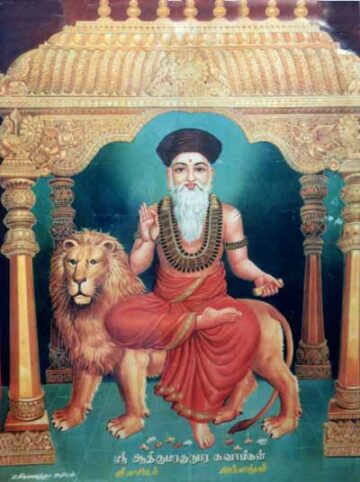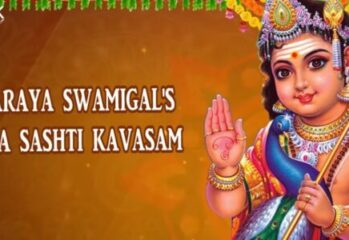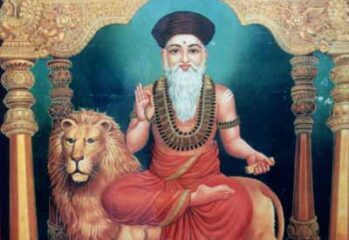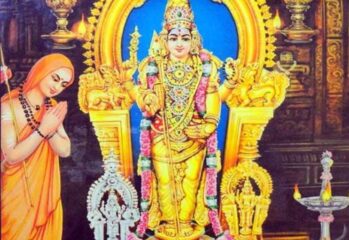A 17th century classic in praise of the glory of Tiruchendur is Kandar Kalivenba by Kumaragurupara Swamigal, a Saiva ascetic. The author was born in 1625 A.D. of a Saiva Vellala family at Srivaikuntam on the northern bank of the Tambaraparani, nineteen miles from Tiruchendur. His parents Shanmukha Sikhamani Kavirayar and Śivakami Ammaiyar were blessed with this child after a long penance to Muruga of Tiruchendur. The boy grew of age and until his fifth year showed no signs of speech. The parents were pained at this and resorted to Tiruchendur penance again. Weary of waiting for months and seeing signs of approaching speech, the parents determined to drown themselves in the sea along with the child if he would not speak by a particular day.

The day dawned, and yet there were no signs. At last, both the parents and the child entered the foamy waves. Deeper and deeper they went from knee to neck and, as they were about to sink with the waves over their heads a human form appeared with a flower in his hand and asked the child what it was; when lo! the child broke out in praise of the Lord with the words of the lines.”Pūmēvu cenkamalap puttēLuntēRRiya
Pāmēvu teyvap pazhamaRaiyum….”
This poem, the Kantarakalivempā of 244 lines is a delightful piece of the Lord’s praise and the truths of Saiva Siddhanta. And it is considered even now with great propriety that its recitation with warmth and fervour wards off many an evil attending on man.
Having studied Tamil at the feet of his father Sanmukacikāmani Kavirayar, and attained in it great proficiency by divine grace, he grew up to manhood, took to an austere way of life, left home, and wandered throughout the Tamil country visiting famous places of pilgrimage and composing poems on the presiding deities.
When he was at Dharmapuram, he was drawn to the monastery’s head Mācilāmani Tecikar, and begged him to be admitted as his disciple and initiated into the sannyāsa āsrama. Mācilāmani asked the young poet to visit important pilgrim centers including Benares, and return to him then. Kumarakuruparar felt incapable of such undertaking, arduous and dangerous in those days. He was directed to stay at least in Chidambaram for some time and then apply. He complied with this condition and afterwards took the holy orders.
While he was a court-poet of Tirumalai Nāyaka at Madurai, one day as he was inaugurating his devotional poem in praise of goddess Mînātci at the royal court, the goddess appeared herself as a young maiden and sat on the lap of the Nāyaka king, and taking a necklace of pearls, put it on the neck of the poet and vanished.
Finally, Kumarakuruparar left for Benares. His fame reached even the Mughal court at Delhi. Emperor Aurangzib expressed a desire to see him, and the poet-saint (who had in the meantime mastered Urdu) rode to the Mughal court on the back of a lion, the symbol of courage and pride. The emperor was so much impressed by the poet’s holiness and learning that he bestowed on him a plot of land in Benares near the Kedar Ghat, and there Kumarakuruparar built the Kumārasvāmi monastery which became soon the heart of religious activities.
He lived in Benares till the end of his days except for a short visit to the South to pay his respects to his guru. The tradition also says that Kumarakuruparar who was very fond of Kampau’s Tamil Rāmāyana lectured on it in Benares and that Tulsîdās, the great Hindi poet of Rāmcaritmānas, heard these talks and became indebted to Kanpan through the lectures of Kumarakuruparar.
Amongst Kumarakuruparar’s other literary works, Meenakshi Pillai-Tamil, Meenakshi-kurram, Neethineri-Vilakkami Madhuraikkalampakam and others are ever popular and widely read.
Unique is the place that Adhi Kumaragurupara Swamigal (1625-88) occupies in the religious, literacy, and educational history of India.
KUMURAGURUPAR
by Mr. S. MURUGESAN
His first utterance by grace of Lord Muruga:
Legend has it that Kumaraguruparar was born dumb in a clan of Kavirayars at Kailasapuram (Srivaikuntam) in Tuticorin District, Tamil Nadu. He got the use of his tongue at the age of five at Tiruchendur by the grace of Lord Muruga, revered for long as the Presiding Deity of the Tamils. His first utterance was ‘Kandar Kalivenba’ an invocation in 244 lines that has come down to generations as a popular recitation among devotees of Lord Muruga in several Tamil-speaking regions of the world. Shri Kasi Mutt has published an English version of the prayer. The opening lines are given below:-
‘You are, verily, the Knowledge
-Kumaragurupara Swamigal
That is beyond the comprehension
of the celestial Creator
that dwells on the red Lotus,
Beyond the ken of the Vedas, ancient and divine,
Beyond even the luminous principle of Nada,
And, indeed, over-reaching even a knowledge that is pure.’
Some scholars find in this verse scientific truths about cosmic energy and its control over Man’s intelligence.
The budding poet adored Lord Kailasanathar at Kailasapuram and addressed ‘Kailai Kalambakam’ to Him.
Goddess of learning answer his Prayer:
The child sage went on a pilgrimage to the North. He was an honoured guest for some time in the palace of Thirumalai Nayak at Madurai. When he composed and recited ‘Meenakshi Ammai Pillaithamil’ – in which Meenakshi is portrayed as the divine child of the Pandiyan king of Madurai – Meenakshi, so the legend goes, appeared and seated Herself on the lap of the King with rapt attention, took a necklace of pearls from him and put it on the saint’s shoulders. He visited many holy places, thoughts with learned men. After his initiation to sannyas at the Dharmapuram Mutt (Thanjavur), he proceeded to Kashi. At Kashi – known as Varanasi or Benares – he learnt in no time Hindustani by invoking the blessings of Goddess Saraswati through a hymn in Tamil ‘Sahalakalavalli Malai’.
Goddess Saraswati is a titular Head of Education. The omniscient Muse in this beautiful poem might have also been a mythical personification of a motherly acharya from whom the Tamil saint learnt the alien language. In his ‘Pandaramummani Kovai’ he had given vent to his devotional feelings for Masilamani Desikar of the Dharmapuram Mutt from whom he learnt the tenets of Saiva Siddhanta. Desikar was regarded here as a manifestation of Lord Shiva. Glorification of such venerations for dedicated teachers has been in tune with the ethos of the culture of this land.
Strangely, what Kumaraguruparar sought from Goddess Sahalakalavalli was not only mastery of language but also supremacy over nations. In the concluding stanza of this ‘Malai’ he sang.
‘Goddess of All learning!
-Kumaragurupara Swamigal
There are myriads of gods and celestial beings like the creator.
But is there one to equal You?
Grant me this boon.
Let all monarchs, who rule over the earth,
Bow unto me the moment I sing.’
Our one-time dumb boy of Kailasapuram had a longing to conquer the world, miraculously – with the gift of the gab. He rode on a lion inside the Mogul Court, and impressed the Moguls with his wordly wisdom, and mystical Knowledge. He got munificent gifts from them.
Missionary Monument at Kashi:
Kashi is ‘the city of light’. One of the 12 ‘jyothirlingam’ is installed here. The Kingdom of Kashi was founded by Kasi Raja about 1200 B.C.
“Benares”, in the words of Mark Twain, the American writer, is “older than history, older than tradition, even older than legend and looks twice as old as all of them put together.”
“Benares, the nerve-center of Indian culture, was the meeting ground of scholars from all parts of India, belonging to different schools and systems”
“Go to Benares or Kashi, that most ancient of cities, and give ear to her murmuring”, Jawaharlal Nehru wrote in a letter to his daughter Indira, “Does she not tell you of her immemorial past – of how she has gone on while empires have decayed, of Buddha who came to her with his new gospel of the millions who have gone to her through the ages to find peace and solace? Old and hoary, decrepit, dirty, smelly, and yet much alive and full of the strength of ages, is Benares. Full of charm and wonder is Kashi, for in her eyes you can see the past of India, and in the murmur of her waters you can hear the voices of ages long gone by”.
Nehru’s words on Benares in his ‘Discovery of India‘ are also worth-quoting here: “Benares has always been a center of learning, and even in Buddha’s day it was old and known as such… There are numerous groups there consisting of a teacher and his disciples, and often between rival groups there was fierce debate and argument”.
Some historians believe that after the sacking of many temples in places like Kashi, major Hindu religious activities shifted from the North to safer places in the South. It is astonishing that during acts of vandalism against Hindu religious centres in Kashi, the undeterred saint of Kailasapuram came to Kashi, on the advice of his guru at Dharmapuram, to spread Saivism.
Francois Bernier, the French physician and historian, in his ‘Travels in the Mogul Empire'(A.D. 1656 -1668) has recorded, “The town contains no colleges or regular classes, as in our universities, but resembles rather the schools of the ancient, the masters being dispersed over different parts of the town in private houses, and principally in the gardens of the suburbs, which the rich merchants permit them to occupy”. Despite religious and political conflicts, large sum of money were lavished in the city of devotees belonging to different religious sects in indiscriminate charity. Kumaraguruparar founded at the Kedar Ghat on the banks of the Ganga mutt known as the Kumaraswamy Mutt. That a Tamil Saivite hailing from the banks of the Tamiraparani succeeded in opening trusts worth millions of rupees with the support of aliens on the banks of the Ganga would be a lasting inspiration to votaries of national integration. His achievement is a monumental example of religious and linguistic harmony inherent in Indian culture. In later years his successors have established and/or financed numerous charities and educational institutions in the country, the most prominent one being the Kashi Mutt at Tirupanadal near Kumabakonam on the banks of the Cauvery.
In Nepal was opened a branch of the Kumaraswamy Mutt. It owned and managed an estate for cultivation of ‘Rudraksham’, beads of rosary worn by Saivites especially those initiated by a guru.
Legendary and historical accounts of Tamil bards are replete with references to gifts received by them. Kumaraguruparar is perhaps the only poet on record out of whose earnings were built centres of learning. Pilgrims from South India to this holy town of Kashi have been on the increase since the establishment of the Mutt. Millions of Hindus have visited Kashi to seek mental peace and spiritual knowledge.
It is often said that no one, even Lord Shiva, can describe in words the greatness of Kashi. Only persons who have experienced its glory can sensitise it. Hence the proverb ‘Kasiku Veesam Jasthi’: Unmeasurable is Kashi’s range.
Lord Viswanath of Kashi is the subject of one of Kumaraguruparar’s poems: ‘Kashi Kalambakam’
Prof. P. Mutharasu has written the following about ‘Kashi Kalambakkam‘ in ‘The Life and Works of Saint Kumaragurupara Swamigal’:
“The greatness of Varanasi lies in the fact that those who breath their last in this place, are granted bliss, without any efforts and with immediate effect. They attain the form of the Lord and remain enjoying the eternal bliss of at His Feet. To enable them to rise to this level, the Lord chants the primal mantra “OM”, into their ears at the time of their death and the divine Mother puts them on her lap and relieve them of their sufferings of countless births by blowing gentle breeze on their face. This boon is granted according to the wishes of the sages. Kumaraguruparar describes this special feature pertaining to Varanasi in several places in this Kalambakam under various circumstances in the words of different persons.
‘Varanasi is otherwise called as Anantha Vanam, where the Lord has cleared the doubts of the Four sages, Janaka etc. , and taught them the four Vedas. Here along, the devotee is sure to be wedded to the damsel of liberation (mukti) without any effort of his own. This aspect though true and beneficial to one and all, is criticised in the words of a drunkard. The saint makes him ask, “Is it really wise on the part of Lord Viswanatha to throw open the granary of mukti to His devotees and to give only two measures of paddy to the Divine Mother?”.
‘Several of the divine exploits of the Lord are referred to with awe and grandeur in the songs of this Kalambakam: but our Saint stresses the point that there is nothing to be suprised at in them, considering the all-powerful nature of the Lord. He states in a song that His feet are real and everlasting abode for the soul, wearied after innumerable births and deaths. The poet-saint wittily remarks, remembering the ceaseless cosmic dance of the Lord, “How can He go to sleep and take rest?”, when He is incessantly active in redeeming the countless souls from bondage. Eventhough the souls attain His Form and attributes at Varanasi, they are conscious of their limitations and the poet says that they will never think of performing His five-fold activities, as it will distract them from meditating on His Feet for ever. The siddhantic conception of the fact that the soul is entitled only for the enjoyment of bliss and for nothing else when liberated is this established.
‘Kumaraguruparar is full of ecstatic feeling when he thinks of His devotees like Sundaramurthy Nayanar and Sandeesa Nayanar. He praises the Tevaram hymns of Sundarar who was the accepted companion of the Lord and feels elated that He who had heard Sundarar’s songs of exquisite sweetness, had accepted his songs also, which were very much inferior in merits. He refers also to the various incidents in the life of Saint Manikavasakar and the exploits of the Lord connected with it. It is interesting to note when the poet says that Brahma and Vishnu will be at a loss to identify Lord Viswanatha, when He stands among His devotees at Varanasi, because of their lack of divine wisdom, love and devotion (48). It is very much surprising when he says that all those who have attained His Form must be prepared to receive beating by the shoe, cane and bow, as he has received them in the hands of His devotees.
‘In the last verse of this garland, Kumaraguruparar advises one and all about the way to attain His blessings and to enjoy perennial bliss. It is the very easy way of praising the Lord with songs of sweet musical words as frequently as possible so that it can become the habit of the tongue.”
Who were the Moguls who patronised this Saivite saint? How did they interact with the non-Tamils and non-Hindus in Kashi? What was his impact on them? In what ways did he influence secular-minded Islamic scholars like Dara Shukoh who was killed by the Aurangzeb, his brother? Answers to these questions are still not clear.
Kumaraguruparar’s Literary Works
- Kandar Kalivenba (Thiruchendur)
- Kailai Kalambakam (Kailasapuram)
- Meenakshiammai Pillaithamil (Madurai)
- Madurai Kalambakam (Madurai)
- Thiruvarur Nanmanimalai (Thiruvarur)
- Muthukumaraswamy Pillaithamil (Vaidiswaran Koil)
- Chidambara Cheiulkovai (Chidambaram)
- Chidambara Mummanikovai (Chidambaram)
- Pandara Mummanikovai (Dharmapuram)
- Sahalakalavalli Maalai(Kashi)
- Kashi Kalambakam (Kashi) and
- Neethi Neri Vilakkam.
Memorable Lessons:
“The life of Kumaraguruparar has some lessons for us today…. He never cared for the linguistic purism of an extreme type that is the fashion in certain quarters today”- A.V.Subramania Aiyar, a versatile scholar.
Pamban Swamigal (1853 (?)- 1928), who earned the title Kumaraguruparadasar for his laudable composition of some intricate verses, stayed at Kumaraswamy Mutt in Kashi in 1902. He was then blessed, with sacred cloths, in a mysterious way, by a devotee of Saint Kumaraguruparar.
Mahatma Gandhi, who began to learn Tamil when he was in South Africa, seemed to have read Kumaraguruparar’s ‘Neethi Neri Vilakkam’. In the course of his visits to Tamil Nad, when a young volunteer urged him to autograph in Tamil, he wrote from the very opening of ‘Neethi Neri Vilakkam’: ‘Human body is a writing on water’. (‘Dinamani Kadir’, Nov 3 1985)
G.U. Pope, a Christian missionary from Europe (1820-1908) who worked for many years at Sawyerpuram near Srivaikuntam, was a scholar in Tamil literary works. He translated ‘Thirukural’ and ‘Thiruvasakam’ into English. He described Neethi Neri Vilakam as the last creative work of the Queen of Tamil Poetry. He commended it as on achievement in the development of communication skills for dissemination of ethical values.
Subramania Bharati (1882-1921), perhaps the greatest nationalist bard of Bharat, turned out to be nationalist after his brief stay at Kashi for higher studies (1898-1902) -admits in his autobiography that he longed for the precocious creative talent of Kumaraguruparar.
Bharatidasan, (1891-1964), popularly known as the Revolutionary Poet, and also several writers belonging to Dravidian atheistic school of thought, have been captivated by the way Kumaraguruparar eulogized the glory and sweetness of the Tamil language.
Puthumaipithan, (1906-1948), one of the most brilliant short-story writers in Tamil, who used to put to ridicule pedantic encouragement to memorisation of Tamil poems, was good at reciting Kumaraguruparar’s ‘Kandar Kalivenba’ during his boyhood.
M. Krishnan, naturalist and wildlife photographer (1913-1996), wrote in a letter he posted to me, (when and he was in his seventies), about his devotion to Kumaraguruparar’s ‘Sahalakalavalli Malai’. He reminisced how his father A. Madhaviah, a biligual novelist (1872-1925) was elated at Krishnan’s memorisation of this poem at a tender age. “If you wake me up at midnight and ask me to sing this wonderful hymn. I would do it with pleasure.”
There was a time when memorisation and recitation of some of Kumaraguruparar’s verses were insisted upon from childhood in order to train the ears and tongues of young learners of the Tamil Language. Let us reassure ourselves of this heritage now – in the present- day context of campaigning for and against the growing popularity of English nursery rhymes even among our first generation learners.
KUMARAGURUPARAR was “a saint among educationists, an educationist among saints”.



